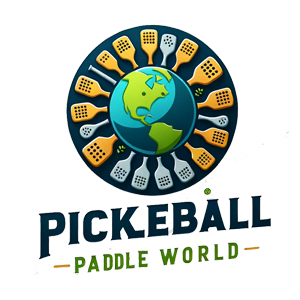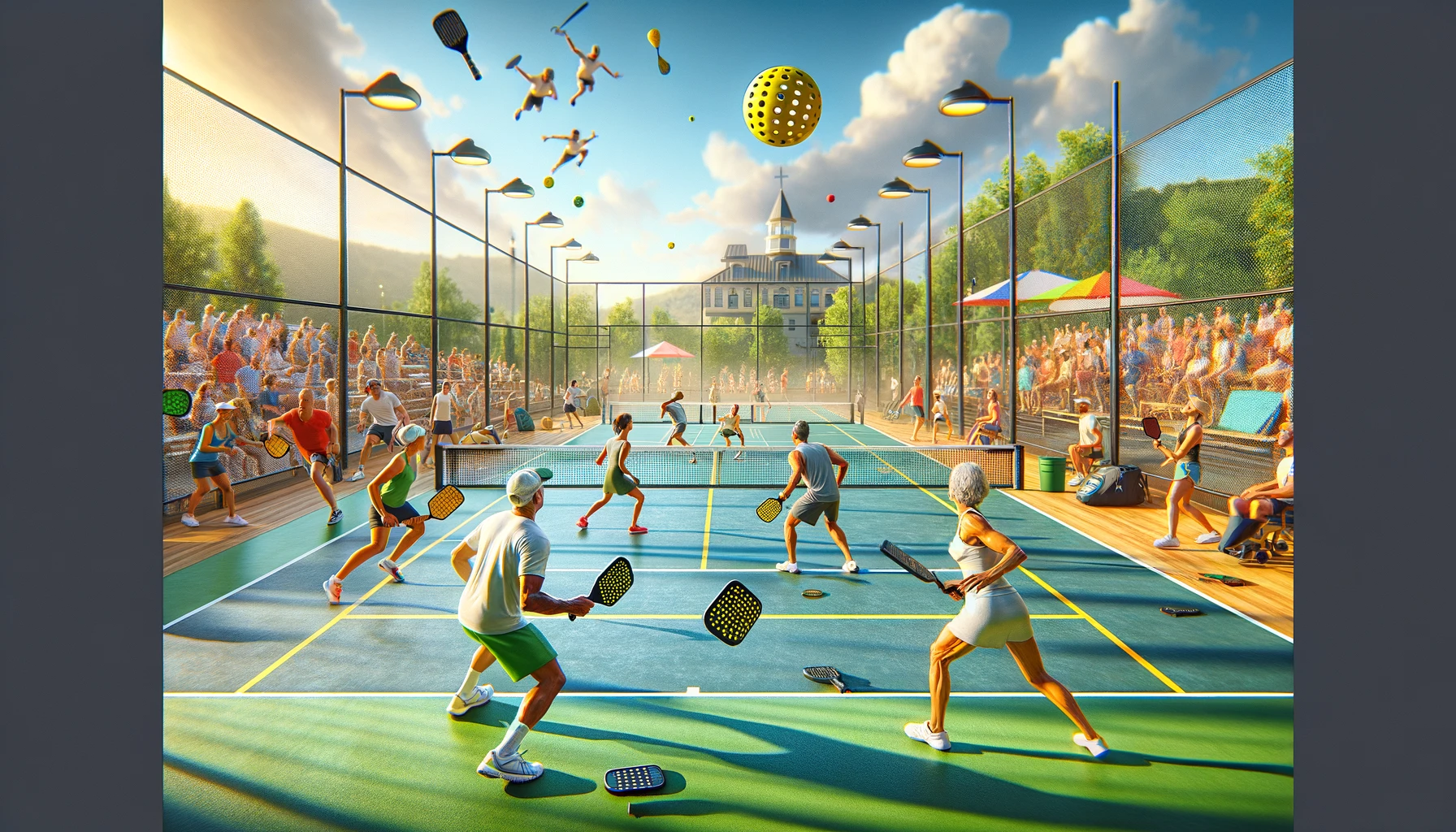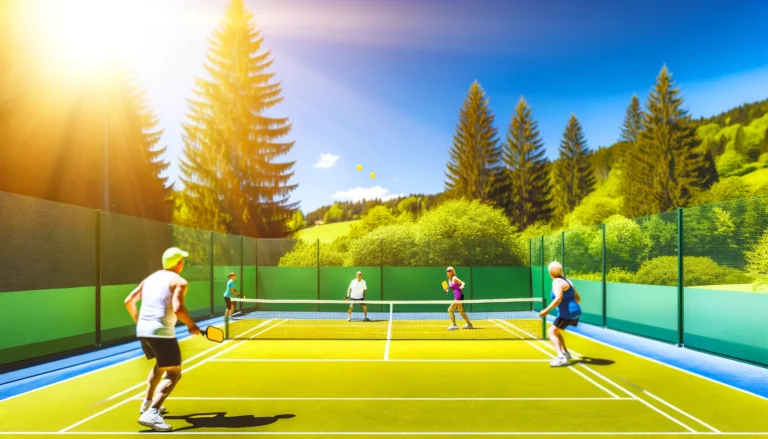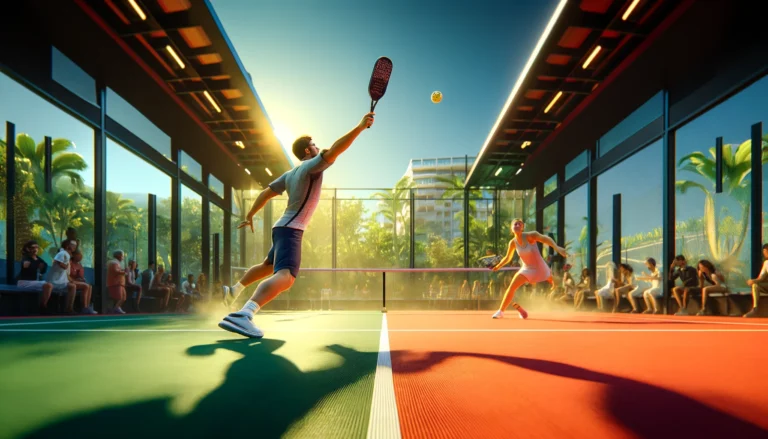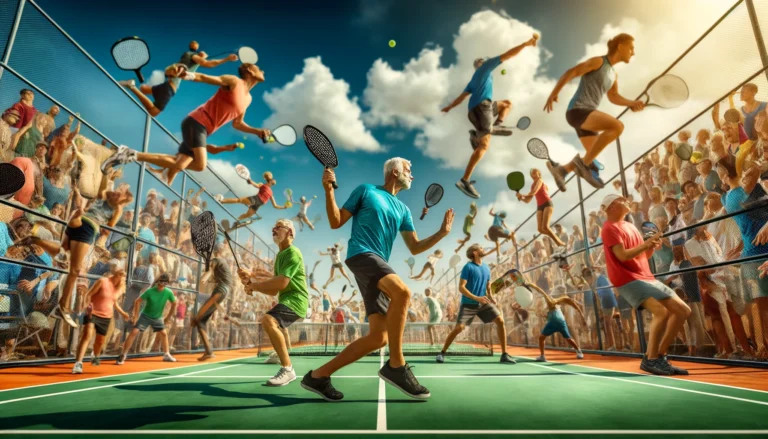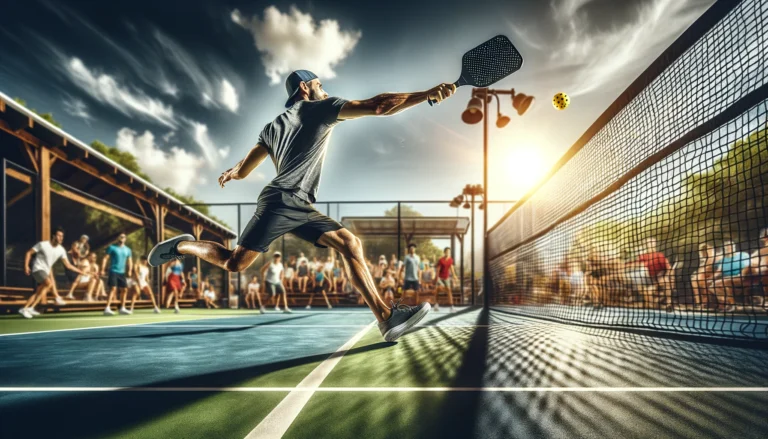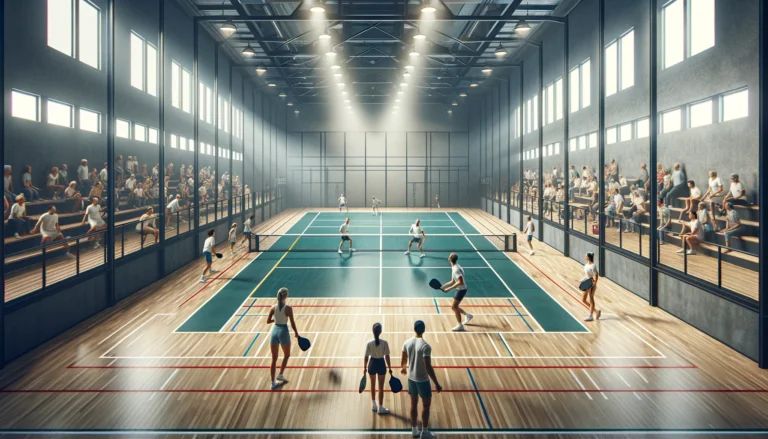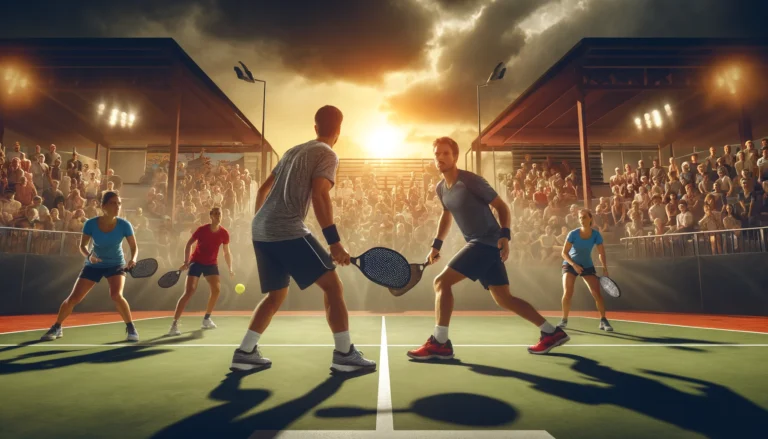What is pickleball?
Introduction
Welcome to the exciting world of pickleball, a sport that’s rapidly capturing the hearts of enthusiasts across the globe. If you’re new here or simply curious about this fascinating game, you’re in the right place. Today, we delve into the heart of a question that’s buzzing in active communities everywhere: “What is PickleBall?”
Pickleball, for those who haven’t yet had the pleasure, is a paddle sport that combines elements of tennis, badminton, and table tennis. It’s known for its accessibility, requiring minimal equipment and accommodating players of all ages and skill levels. This blend of simplicity and versatility is precisely what’s propelled pickleball into the spotlight, transforming it from a backyard pastime into an internationally recognized sport.
But what makes pickleball more than just a game? Why is it that communities around the world are not only picking up paddles but also advocating for more courts, organizing tournaments, and fostering a welcoming, inclusive environment? In this post, we’ll explore the intricacies of pickleball rules, the essential equipment you’ll need to get started, and the unique aspects that make this sport so beloved. From the adrenaline-pumping action of “3 person pickleball” to the strategic choices behind selecting the best pickleball paddle, we invite you on a journey to uncover the allure of pickleball and why it’s becoming a staple in recreational and competitive scenes alike.
So, whether you’re here to learn what a pickleball looks like, understand the game’s fundamentals, or simply discover a new way to stay active, join us as we unwrap the layers of this captivating sport. Welcome to the world of pickleball – where fun, fitness, and friendship meet on a court near you.
The Basics of PickleBall
Pickleball stands as a distinct sport, ingeniously blending the dynamics of tennis, badminton, and table tennis into a uniquely enjoyable game. At its core, pickleball is played with paddles and a plastic ball with holes, resembling a wiffle ball, on a court that echoes the dimensions of a badminton court with a net similar to tennis but slightly lower. This fusion creates a gameplay experience that is both accessible and challenging, offering a fast-paced game that requires agility, strategy, and finesse.
The inception of pickleball is a tale of innovation and spontaneity. Created in 1965 on Bainbridge Island, Washington, by Joel Pritchard, Bill Bell, and Barney McCallum, the game was born out of a desire to entertain their families over the summer. Finding the badminton equipment incomplete, they improvised with ping-pong paddles and a perforated plastic ball. As the game evolved, they developed rules, aiming to create a sport that could be enjoyed by players of all ages. The name “pickleball” itself has a whimsical origin, though stories vary, with the most popular being that it was named after the Pritchards’ dog, Pickles, who loved to chase the ball around the court.
The objective of pickleball is straightforward: players aim to win points by serving the ball across the net, attempting to outmaneuver their opponents to land the ball in the opposing court area without the chance of a return. Matches can be played in singles or doubles format, making it a versatile sport for different group sizes.
Basic rules that govern the game include the serve, which must be done underhand and diagonally across the court to the opposite service box, and the unique ‘two-bounce rule,’ where the ball must bounce once on each side of the net before volleys are allowed. This rule encourages longer rallies and strategic play. The non-volley zone, or “the kitchen,” extends seven feet from the net on both sides, where players are prohibited from performing volleys, adding a layer of tactical depth to the game.
Pickleball’s simplicity in rules and equipment requirements, combined with its engaging gameplay, has contributed to its burgeoning popularity. It’s a sport that emphasizes fun, social interaction, and physical activity, making it a cherished activity among communities worldwide. Whether you’re eight or eighty, pickleball offers a delightful way to engage in competitive play while enjoying the company of others, embodying the spirit of inclusivity and joy in sports.
The Appeal of Pickleball
Pickleball’s meteoric rise in popularity can be attributed to its wide appeal across various ages and skill levels, making it an inclusive sport that welcomes everyone. This universal appeal stems from the game’s easy-to-learn nature, low-impact movement, and the minimal equipment required to play, breaking down barriers to entry that are often seen in other sports. It’s a game that grandparents can enjoy with their grandchildren, friends can play on a sunny afternoon, and athletes can compete in with intensity and skill.
Accessibility and Flexibility
One of the primary reasons pickleball is so appealing is its accessibility. The rules are simple, the equipment is minimal, and the physical demand is manageable, allowing people of all ages and fitness levels to participate. Unlike tennis or badminton, which may require more stamina and agility, pickleball’s smaller court size and the slower pace of the plastic ball make it easier for players to engage in the game without extensive athletic training. This accessibility fosters a welcoming environment for newcomers, encouraging participation from individuals who might shy away from more physically demanding sports.
Social and Health Benefits
Pickleball offers significant social and health benefits, contributing to its appeal. On the social side, the game is typically played in doubles, promoting teamwork and communication. Pickleball courts have become community hubs, where friendships are formed, and social interaction thrives. The sport’s community aspect cannot be overstated; it creates opportunities for social gatherings, tournaments, and casual play that strengthens community bonds.
From a health perspective, pickleball provides a fantastic cardiovascular workout, improving heart health, and boosting overall fitness. The game involves a lot of movement—running, stretching, and striking—which enhances physical agility and coordination. Furthermore, the strategic nature of the game stimulates mental acuity, challenging players to think quickly and adapt their strategies on the fly. For older adults, engaging in pickleball can help maintain physical fitness, improve balance, and reduce the risk of chronic diseases, all while offering a fun and social way to stay active.
“3 Person Pickleball” – A Unique Twist
A unique variant that highlights pickleball’s flexibility is “3 person pickleball,” an adaptation that allows three players to enjoy the game together. This version can involve rotating players in and out, ensuring everyone gets to play without the need for a fourth player. It’s an excellent way to enjoy pickleball’s benefits when gathering a larger group isn’t possible, showcasing the sport’s adaptability to different group sizes and settings.
This three-player format emphasizes the game’s core appeal: regardless of the number of participants, pickleball remains a fun, engaging, and accessible sport. Whether you’re enjoying a competitive game, a family outing, or a casual play session with friends, pickleball offers a welcoming and inclusive environment. Its appeal lies not just in the physical game but in the connections it fosters, the health benefits it provides, and the joy it brings to communities worldwide.
Equipment and Court Setup
To fully enjoy and participate in the sport of pickleball, understanding the necessary equipment and court setup is essential. This knowledge ensures that players are well-equipped and that games are played in an environment that adheres to standard regulations, providing a fair and enjoyable experience for everyone involved.
Essential Pickleball Equipment
At its core, pickleball requires just a few key pieces of equipment: a paddle, a ball, and proper attire.
Paddles: Pickleball paddles are larger than table tennis paddles but smaller than tennis rackets. They are made from various materials, including wood, composite, and graphite. The choice of paddle can significantly affect your gameplay, with factors such as weight, size, and grip playing crucial roles in performance.
Balls: A distinctive aspect of pickleball is its ball, which is unique to the sport. The pickleball is made of durable plastic with holes through it, similar to a wiffle ball. It’s designed to fly with precision but not as fast as a tennis ball, allowing players of all levels to have better control over their shots. What does a pickleball look like? It is typically bright yellow, green, or white, making it easily visible against the court and sky, with a diameter of about 2.9 inches and weighing about 0.85 ounces. The ball’s construction is geared towards outdoor and indoor play, with different designs optimized for each environment.
Proper Attire: While there is no strict dress code for pickleball, players are advised to wear comfortable sports attire that allows for easy movement. Lightweight, breathable clothing paired with sturdy, supportive athletic shoes provides the best experience. Shoes designed for court sports offer the best traction and support on the pickleball court.
Court Dimensions and Setup
The pickleball court is a rectangle that measures 20 feet in width and 44 feet in length, making it identical in size to a doubles badminton court. The net is hung at a height of 36 inches at the sidelines and dips to 34 inches in the center, slightly lower than a tennis net.
The court is divided into several key areas:
The Non-Volley Zone (NVZ) or “The Kitchen”: Extending 7 feet from the net on both sides, this area is where players are prohibited from volleying the ball (hitting it in the air without letting it bounce first). This rule encourages strategic gameplay and rallies.
Service Areas: The court is further divided into right and left service areas on each side, where players serve diagonally across the court to their opponents’ corresponding service area.
Baseline and Sidelines: These define the outer boundaries of the court, with specific rules governing play and scoring related to these lines.
Understanding the equipment and court setup is crucial for anyone looking to get involved in pickleball. Whether you’re setting up a makeshift court at home or heading to a local community center, having the right gear and a basic knowledge of the court dimensions will enhance your playing experience, ensuring you enjoy every moment of this engaging sport.
Pickleball Paddles – The Heart of the Game
Pickleball paddles, the primary tool of the game, are more than just equipment; they are the extension of the player’s body, influencing every serve, volley, and smash. The quest to find “the best pickleball paddle” is a journey every enthusiast embarks on, seeking a blend of performance, comfort, and style that suits their individual play. Understanding what constitutes a good pickleball paddle can significantly enhance your game and enjoyment of the sport.
What Makes a Good Pickleball Paddle?
The ideal pickleball paddle combines several key features: material composition, weight, size, and grip. Each element plays a crucial role in how the paddle performs and feels during play.
Material Composition: Modern pickleball paddles are made from a variety of materials, each offering different benefits. Wood paddles are affordable and durable but tend to be heavier. Composite paddles, made from a blend of materials like fiberglass or carbon fiber, offer a good balance of weight and power and come in a range of surface textures for better ball control. Graphite paddles are lightweight and provide excellent responsiveness and control, making them a favorite among experienced players.
Weight: A paddle’s weight is a critical factor in its performance. Lightweight paddles (under 7.3 ounces) offer greater control and are easier on the arm, making them ideal for players who value precision and have longer play sessions. Medium-weight paddles (7.3 to 8.4 ounces) provide a balance between power and control, suitable for a wide range of playing styles. Heavy paddles (over 8.4 ounces) deliver more power but can be more challenging to maneuver, recommended for players with strong, aggressive swings.
Size: The size of the paddle impacts its playability. A larger paddle face offers a bigger hitting surface and sweet spot, which can be forgiving for beginners. However, larger paddles tend to be heavier. The paddle’s length and width should also be considered, as they influence reach and surface area.
Grip Size and Texture: Grip size should match the player’s hand for comfort and to prevent injuries. A proper grip allows for a firm hold without straining the hand muscles. Texture on the paddle’s handle can also affect play, providing additional comfort and sweat absorption.
What to Look for in a Pickleball Paddle
When selecting a pickleball paddle, consider the following advice, integrating expert opinions and player preferences:
Play Style: Your playing style is paramount when choosing a paddle. If you prefer a game based on control and finesse, a lighter paddle with a large surface area and softer material may be best. For a power-driven game, a heavier paddle with a stiffer material might be more suitable.
Comfort: Prioritize paddles that feel comfortable in your hand and during play. This includes the grip size, the paddle’s balance, and how it feels when hitting the ball.
Trial and Feedback: If possible, test various paddles before making a purchase. Many clubs and stores offer demo programs. Feedback from fellow players, especially those with a similar playing style or level, can also be invaluable.
Quality and Durability: Look for paddles made by reputable manufacturers that offer warranties or guarantees. A well-made paddle not only performs better but will also withstand the rigors of play over time.
Finding “the best pickleball paddle” is a personal journey that can significantly impact your game. By understanding the elements that contribute to a paddle’s performance and matching them to your needs and preferences, you can elevate your pickleball experience, enjoying every moment on the court with confidence and control.
Playing the Game – Rules and Scoring
Pickleball combines elements of tennis, badminton, and table tennis, creating a unique game that is both accessible and complex in its strategic depth. Understanding the rules and scoring system is crucial for both beginners and seasoned players alike. Let’s dive into the specifics of how pickleball is played, including the rules for serving, scoring, and common faults, along with some strategic tips for those new to the game.
How Pickleball is Played
Pickleball can be played as singles or doubles, with the basic premise being to hit the ball over the net within the bounds of the opponent’s court area, trying to prevent them from being able to return it. The game starts with a serve, which must be done underhand, with the paddle below the waist level, and diagonally across the court to the opponent’s service box. The serving side continues to serve until they commit a fault, at which point the service passes to the opposing side.
Scoring System
Pickleball uses a unique scoring system where only the serving team can score points. Games are typically played to 11 points, and a team must win by at least 2 points. The serve rotates between team members each time the serving team wins a point in doubles play. In announcing the score, the server’s score is called first, then the receiver’s score, and finally, in doubles, the server number (one or two).
Serving Rules and Faults
Serving Rules: The serve must be hit underhand and the ball must be hit in the air on the serve; it cannot be bounced and then hit. The serve must clear the non-volley zone, including the line, and land in the diagonal service box.
Faults: Faults occur when the ball is hit out of bounds, does not clear the net, is volleyed from the non-volley zone, or is not served properly. A fault results in the loss of the serve or a point for the opposing team if they are serving.
Tips for Beginners
Master the Serve: Consistency and placement are more important than power. Practice serving deep into the opponent’s court to push them back and open up the court.
Control the Non-Volley Zone: Also known as “the kitchen,” controlling this area is key to dominating the game. Work on your dinks (soft shots that land in the opponent’s non-volley zone) and volleys to win the net battle.
Develop a Soft Game: While powerful shots are important, having a good soft game can make you unpredictable and difficult to defend against. Practice drop shots that land just over the net in the non-volley zone.
Stay Patient: Pickleball often involves long rallies and strategic placement. Resist the urge to go for a winning shot too early in the rally. Instead, wait for a clear opening.
Improve Footwork: Good footwork is essential for getting into the right position to hit the ball. Focus on staying on your toes and moving efficiently around the court.
Understanding and applying the rules of pickleball, along with developing strategic play, can significantly enhance your enjoyment and performance in the game. Whether you’re a beginner looking to learn the basics or a seasoned player aiming to refine your strategy, the game of pickleball offers endless fun and competitive challenges.
How to Get Started with Pickleball
Embarking on your pickleball journey is an exciting endeavor that opens up a world of fun, fitness, and camaraderie. This step-by-step guide is designed to help beginners navigate the initial stages of playing pickleball, from locating places to play to selecting equipment and finding resources for improving your game.
Finding Local Courts and Communities
Online Directories and Apps: Websites like the USA Pickleball Association (USAPA) offer directories of local pickleball courts and facilities. Mobile apps dedicated to pickleball can also help you find nearby locations and connect with local players.
Community Centers and Sports Clubs: Many community centers, YMCAs, and sports clubs have pickleball courts. These venues often offer the added benefit of being able to rent equipment, making it easy to try the sport without a significant initial investment.
Social Media and Forums: Join local pickleball groups on social media platforms or pickleball forums. These communities are great resources for finding playing locations and can also provide insights into where the most active players gather.
Choosing Your First Equipment
Choosing the right equipment is crucial for a comfortable and enjoyable start to your pickleball journey.
Pickleball Paddle: For new players, the question of “what is the best pickleball paddle” often arises. A good starting point is a medium-weight paddle (around 7.3 to 8.4 ounces) with a composite material. This offers a balance between power and control, making it forgiving for beginners while allowing for growth in the game.
Balls: Pickleball balls are specific to the sport, with outdoor balls having 40 holes and indoor balls having 26 holes. Starting with the type of ball that matches where you’ll be playing most often is a good idea.
Attire and Shoes: Wear comfortable, breathable athletic clothing and ensure you have shoes designed for court sports to prevent slipping and provide support.
Learning Resources
Classes: Look for beginner clinics and classes at local sports centers or pickleball clubs. These sessions provide hands-on learning and an opportunity to ask questions and practice with guidance.
Online Tutorials: There’s a wealth of online resources available for learning pickleball basics, from serving to scoring. YouTube channels dedicated to pickleball can be particularly helpful.
Books: For those who prefer learning through reading, several books on pickleball cover everything from the rules of the game to strategies for improvement. Titles like “The Art of Pickleball” or “Pickleball Fundamentals” come highly recommended.
Starting your pickleball journey is as simple as showing up to a local court with the right attitude and some basic equipment. The sport’s welcoming community and the game’s accessibility mean that you’ll find plenty of support along the way. Whether you’re looking to play competitively or just for fun, pickleball offers something for everyone. Remember, the key to improvement is consistent play, so grab a paddle and hit the courts as often as you can. Welcome to the pickleball family!
The Future of Pickleball
As we look ahead, the future of pickleball shines brightly, promising continued growth and innovation. This dynamic sport, rooted in community and inclusivity, is poised for unprecedented expansion, both in the number of enthusiasts and in its global reach. Let’s explore the trajectory of pickleball’s growth, the burgeoning ecosystem of clubs and tournaments, and the exciting potential developments on the horizon.
Growth of Pickleball: Clubs, Tournaments, and Global Reach
Pickleball’s appeal has transcended its humble beginnings, evolving into a global phenomenon. The sport’s growth is evidenced by the exponential increase in pickleball clubs and community groups. These organizations serve as the backbone of the sport, fostering a sense of community, facilitating matches, and providing resources for players of all levels.
Tournaments, from local competitions to national championships, have become a staple of the pickleball landscape, attracting players from diverse backgrounds. The competitive scene is flourishing, with events offering categories for various age groups and skill levels, ensuring that everyone has a chance to compete. This inclusivity is one of the pillars of pickleball’s success.
Internationally, pickleball is gaining traction, with countries around the world establishing their own federations and leagues. This global embrace of the sport hints at the potential for international competitions that could rival those of more established sports, fostering a worldwide pickleball community.
Potential Future Developments
Technology in Paddles: The evolution of equipment, particularly paddles, is a key area of innovation in pickleball. Advances in materials science and engineering are likely to produce even lighter, stronger, and more responsive paddles, enhancing playability and performance. Smart technology could also be integrated, offering players data on their performance, such as swing speed and impact accuracy, directly from their paddle.
International Competitions: As pickleball’s popularity continues to soar globally, the potential for international tournaments and perhaps inclusion in multi-sport events like the Olympics becomes more plausible. Such developments would not only elevate the sport’s profile but also encourage cross-cultural exchange and unity through pickleball.
Youth Engagement and Professionalization: Engaging younger players is vital for the sport’s long-term growth. Initiatives aimed at introducing pickleball into schools, alongside the development of youth leagues, can foster early interest and talent. Moreover, the professionalization of the sport, through sponsorships, professional circuits, and televised coverage, can provide career pathways for elite players.
Technology and Accessibility: Technological advancements, such as online platforms for finding players and courts, training apps, and virtual reality simulations for practice, could make learning and enjoying pickleball even more accessible to a broader audience.
The future of pickleball is not just about growth in numbers but also about deepening the sport’s impact on communities, enhancing the player experience through technology, and elevating the level of competition and professionalism. As pickleball continues to evolve, it will undoubtedly remain a sport cherished for its inclusivity, health benefits, and the joy it brings to those who play it. The journey ahead for pickleball is as exciting as the game itself, promising new developments, challenges, and, most importantly, more fun on the courts for everyone.
Conclusion
Pickleball stands out in the sports world not just as a game but as a growing global community bound by a shared love for fun, competition, and camaraderie. It’s a sport that ingeniously combines elements of tennis, badminton, and table tennis, creating a unique and accessible game that can be enjoyed by people of all ages and skill levels. From its humble beginnings on Bainbridge Island to its current status as one of the fastest-growing sports in the world, pickleball has captured the hearts of millions.
This exploration into “What is PickleBall?” has unveiled the simplicity and complexity of the game, the essential equipment needed to play, and the profound impact it has on its players’ social and physical well-being. We’ve delved into the intricacies of pickleball paddles, the heart of the game, and highlighted the significance of choosing the right equipment. The rules, scoring, and strategic tips provided a glimpse into the tactical depth of pickleball, inviting players to engage in continuous learning and improvement.
For those standing on the sidelines, curious and contemplating whether to join in, the message is clear: there’s never been a better time to pick up a paddle and experience the joy of pickleball. The sport’s inclusive nature and supportive community provide a welcoming environment for newcomers, with local clubs, online resources, and friendly pick-up games offering multiple pathways to get involved.
As pickleball continues to evolve and expand its reach, the opportunities for play, competition, and connection are boundless. Whether you’re seeking a fun way to stay active, looking to meet new friends, or aiming to compete at the highest levels, pickleball offers something for everyone. The joy and benefits of this dynamic sport are waiting to be discovered, inviting you to step onto the court and join the ever-growing pickleball family.
We encourage you to explore more about pickleball, deepen your understanding of the game, and connect with the vibrant community of players at pickleballpaddleworld.com. Here, you’ll find resources, tips, and stories that celebrate the spirit of pickleball and inspire players to embrace the game’s challenges and rewards. Welcome to the world of pickleball – where every game is an opportunity for fun, growth, and connection.
As we wrap up our journey through the vibrant world of pickleball, we invite you to take the next step with us. Whether you’re newly intrigued by this fast-growing sport or looking to refine your game with the perfect paddle, pickleballpaddleworld.com is your go-to destination. Dive into our extensive collection of reviews, where we meticulously analyze and recommend the best pickleball paddles suited for every level of play. From beginners seeking their first paddle to seasoned veterans aiming to elevate their game, our insights are designed to guide you to your ideal match.
But our community thrives on more than just expert reviews. Your stories, experiences, and queries make pickleballpaddleworld.com a richer, more engaging platform for pickleball enthusiasts worldwide. We encourage you to share your pickleball journey in the comments below. Whether you’re celebrating your first win, looking for advice on mastering the soft game, or have questions about starting out, your insights contribute to our collective knowledge and the global pickleball community’s growth.
Your voice matters to us. Engage with fellow readers, exchange tips, and share the joys and challenges of your pickleball experience. Together, we can foster a welcoming space for all players to learn, improve, and connect over our shared passion for pickleball.
So, what are you waiting for? Browse through our reviews to find your next game-changing paddle, and don’t hesitate to reach out in the comments with your pickleball stories and questions. Let’s continue to grow this incredible sport together. Welcome to the family at pickleballpaddleworld.com—your paddle awaits!
